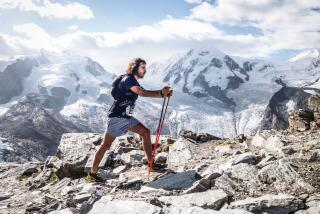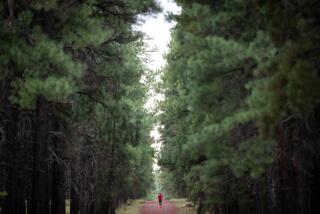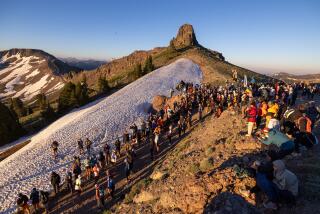Race Attracts Runners With Special Calling : Trans-America: Entrants will run 64 days, from Huntington Beach to New York City.
- Share via
HUNTINGTON BEACH — The Japanese folk-singer is ready to run. The Fresno grandfather is just out to survive. And the Australian gardener? He hopes to make it to the finish line--powered by mango slushes and Vegamite pasta.
Welcome to the second Trans-America Footrace, in which entrants from around the world will try to run nearly 3,000 miles--Huntington Beach to New York City--in 64 days. It begins at 5 a.m. Saturday, where the Santa Ana River meets the surf at Huntington Beach.
Call it crazy, obsessive, perhaps a cry for help. The runners in this race--12 men, two women--have heard it all before.
“People sweep us under the carpets as being fruitcakes or misfits,” says Trans-Am entrant Patrick Farmer, 31, of Sydney, Australia. “But it’s just natural human progression to look for further distances. We’re just ahead of our time.”
Maybe so. But even ultrarunners, as they call themselves, admit they pay a price for pushing the limits of long distance.
Huntington Beach resident David Warady, who won the Trans-Am last year, says it wasn’t until last month he was able to run again effectively, such was the extent of his injuries. Same with Tom Rogozinski of Maryland; he finished third last year despite running much of the race with stress fractures in his feet. And Milan Milanovic of Switzerland? Nine months after finishing second, he said he may never run again.
In fact, of the 13 runners who finished the inaugural Trans-Am--28 started--only one, Ed Kelley of Long Beach, plans to line up Saturday for Trans-Am II.
“I have a lot to prove,” says Kelley, who finished sixth last year after suffering, among other ailments, food poisoning, the flu and a liver infection. “Though I’m kind of wondering why I came back.”
Why is the question ultrarunners are asked, especially in a race such as this. Why run across the desert in the summer heat? Why run up and over the Rocky Mountains? Why pay a $1,000 entry fee to run an average of 45 miles per day for 64 days, sleep on gymnasium floors and in church halls and eat bologna sandwiches, soda pop, M&Ms; and Ding Dongs?
The most popular answer is: the challenge. Seeing how far you can push yourself, aching feet, knees, hips and all. Surviving the elements, knowing when to ease up, when to push harder, when to sing or recite the alphabet to keep your mind from focusing on pain. But each runner seems to have his inspiration.
Farmer, one of the favorites, says he will beat the monotony by visualizing the finish line--and his wife in Sydney. Apparently, it has worked for him before. Two years ago, he ran from the northern tip of Australia to the southern tip of Tasmania, nearly 4,000 miles for charity, wading through crocodile-infested rivers along the way.
Dick Rozier of Fresno, 63, a grandfather of 20, says he’s running Trans-Am II to celebrate his recent retirement after 31 years in the insurance industry. “I’m just going to try to survive,” he says.
Lorna Michael, 34, of Wausau, Wis., and Diane Dakan, 39, of Cathedral City, Calif., will try to become the first women to complete a trans-continental running race.
Tomoya Takaishi, 51, is something of a cult figure in Japan. He’s a popular singer and runner. He once ran from Sydney to Melbourne, Australia, (631 miles) in 8 days, 11 hours. A sizable contingent of Japanese newspaper and TV reporters is expected to record his every step.
Gutadayzke, a school librarian from St. Louis, was a volunteer in last year’s race. Other entrants are coming from France, Germany and Morocco.
If Trans-Am II is anything like Trans-Am I, entrants can expect more than aching bodies and sunburned noses. Last year, one runner kept the others entertained by dodging traffic to pick up loose coins on the highway. Another was “pulled over” in the middle of nowhere by a highway patrolman who didn’t like the fact the runner relieved himself on the side of the road instead of running 39 more miles to the nearest restroom. And everyone seemed enthralled by a dead snake a runner carried from aid station to aid station.
This year, they’ll run into their own adventures as they follow the course--marked with flour--through places like Kelso, Calif., Beaver, Utah, Fruita, Colo., Cuba, Kan., South Vienna, Ohio and into New York City’s Central Park. Sixty-four stops in all. Sixty-four days of putting one foot in front of the other.
John Loeschhorn of UltraRunning magazine, writing about the mystery of Warady’s tenacity, put it this way: “How could he explain the satisfactions derived from finishing each day, bone tired, but still running, running in spite of ankles the size of cantaloupes and in spite of crimson blisters like leeches clinging to his feet?”
This year, Warady will simply help the race crew during the first four days. He says finishers will probably need at least nine months to recover, though that’s just from the physical effects. The mental side, he says, can take longer.
“It was difficult,” Warady says about the post-race letdown. “Here I had finished this great thing, I had all this incredible energy and power and feeling that I could knock the world dead. But I went from Superman to Superman looking for a new adventure. I still feel that way. I have all this incredible ability and foresight and energy, but I don’t have anything to channel it into.”
At least not until Trans-Am III.
More to Read
Sign up for The Wild
We’ll help you find the best places to hike, bike and run, as well as the perfect silent spots for meditation and yoga.
You may occasionally receive promotional content from the Los Angeles Times.






